How to Freeze String Beans
This post may contain affiliate links, which means that I may receive a commission if you make a purchase using these links. As an Amazon Associate I earn from qualifying purchases.
Freezing string beans is a great way to preserve them for future meals. You don’t even need any special equipment. Learn how to freeze string beans with or without blanching using basic supplies that you already have in your kitchen.

When it comes to growing a vegetable garden, there’s no doubt that string beans are one of the most popular crop to grow. They come in so many varieties, shapes, and colors.
String beans are easy to grow and can produce an abundant harvest. Since beans are our favorite, I tend to grow several bush and pole varieties so that I have plenty for fresh eating and preserving.
- Bush beans grow rapidly into compact plants that flower and produce bean pods that are ready for harvesting within 45-50 days. Bush beans are usually mature around the same time, making them a perfect choice for preserving. If you succession plant bush beans every four weeks, you will have plenty for fresh eating and preserving throughout the growing season.
- Pole beans grow slower, but you will get more yields per plant than bush beans. Provide pole beans with a trellis support and they will wrap themselves around and up the support as they grow. Only when the vines are established will pole beans begin to blossom and produce beans. Once they do, you will be able to continue harvesting until your first fall frost.
While I prefer to preserve string beans by canning them or turning them into pickled dilly beans, I rely on freezing a few bags as well. I find that freezing beans locks in more of that fresh green bean flavor than canning does.
Frozen green beans are useful to have on hand for a quick side dish. Simply boil the beans until tender, drain, and top with a pat of butter. They are also handy for adding to soups and stir frys. Just scoop out a handful at a time and cook as you would fresh beans.
Do you have to blanch string beans before freezing?
Blanching is the process of partially cooking the beans in boiling water, and then plunging them into ice water to stop the cooking process. Pre-cooking before freezing helps slow the enzymes that can cause lost flavor, color and texture. Blanching also kills and washes off any microorganisms that might be on the surface of the food.
I usually blanch string beans before freezing, but sometimes if it is a choice between the beans going bad and freezing, I will rinse them well and toss them whole into freezer bags without blanching.
You don’t need to blanch the string beans if you plan on using them in less than 3 months. Just be sure to rinse it very well before freezing and cook before eating. You can skip the blanching step.
If you want your string beans to last longer in the freezer, go ahead and blanch it before freezing. Properly blanched, packaged, and frozen string beans will maintain a higher quality for approximately 12 months.
Steps to Freezing String Beans
Harvest your string beans in their prime when they are still small to medium sized and tender without large seedpods. Freeze them the same day for the best quality, or wash and store in the refrigerator for a day or two until you are ready to preserve. One pound of cut string beans will fit in a quart sized freezer bag.
String beans grow quickly and I like to pick them every day, so they don’t grow too big, but sometimes they get away from me. The large or seedy pods may taste ok when eating fresh, but they don’t hold up very well to freezing and tend to get tough.

You’ll find a printable recipe at the bottom of this post, but here are the illustrated steps to freeze string beans for food storage:
Step 1: Gather your equipment
Simple kitchen equipment is all you’ll need to freeze string beans:
- Large pot of water
- Colander or mesh strainer
- Large bowl of ice water
- Knife
- Cutting Board
- Baking sheets
- Parchment paper
- Zipper type freezer bags
- Kitchen towels
Step 2: Prepare the string beans
Rinse the string beans under running water, remove the strings, trim ends, leave whole or cut into pieces.
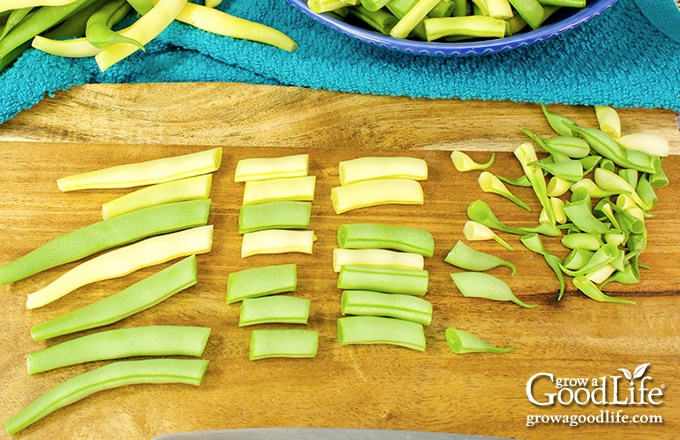
Step 3: Blanch the beans
Bring a large pot of water to a rapid boil. Lower the string beans into the boiling water and boil for 3-minutes.
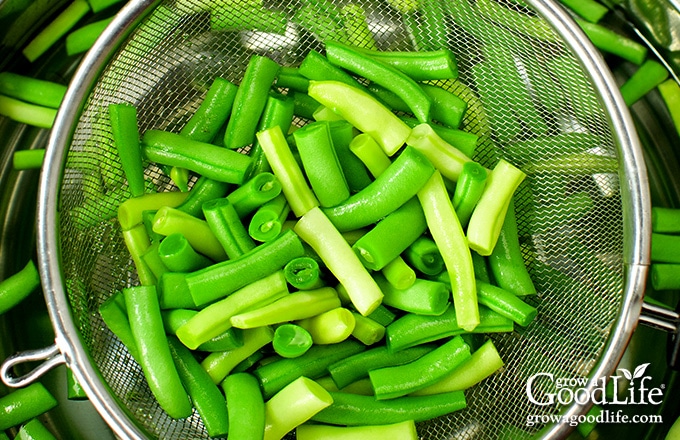
Remove the beans and plunge into the bowl of ice water to cool for about 5 minutes. Once the beans have cooled, scoop it out and dry on a clean kitchen towel.
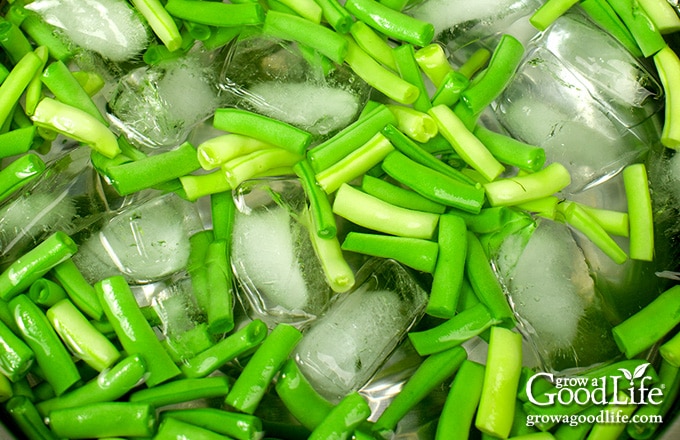
Step 5: Flash freeze the string beans on baking sheets
Pre-freezing the beans before storing in freezer bags will help prevent the pieces from sticking together and allow you to grab a handful when needed for meals.
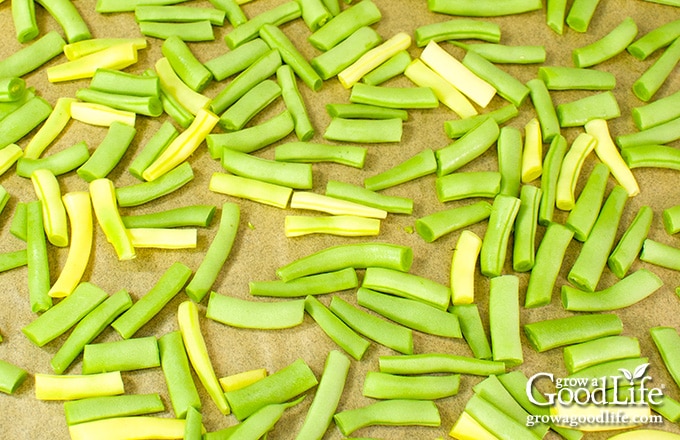
To pre-freeze, layer your baking sheets with parchment paper. Spread the beans out on the sheets so they are not touching. Place the baking sheets in the freezer until they are frozen solid, about 1 to 2-hours.
Step 6: Package into freezer bags
Place the frozen beans into freezer bags, remove the air, and seal the bag. Label, date, and store the beans in the freezer until you are ready to use in your favorite recipes. Use within 10-12 months for the best quality.
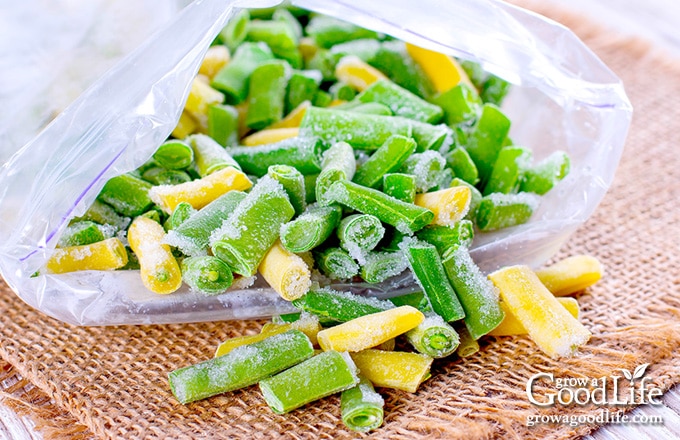

How to Freeze String Beans
Ingredients
- 4 pounds fresh string beans
Instructions
- Rinse the string beans under running water, remove the strings, trim ends, leave whole or cut into pieces.
- Fill a large bowl with ice and cold water.
- Bring a large pot of water to a boil over high heat.
- Once the water is boiling, add the string beans and boil for 3-minutes.
- Remove the beans and plunge into the bowl of ice water to cool for about 5 minutes.
- Once the beans are cool, drain and place them on a clean kitchen towel and pat dry.
- Layer several baking sheets with parchment paper, and spread the beans on the trays so they are not touching.
- Place the baking sheets in the freezer and freeze until the beans are frozen, about 1 to 2-hours.
- Transfer the frozen beans to freezer bags, squeeze to remove air, and seal the bag. Label, date, and store in the freezer until ready to use in your favorite recipes. Freeze for up to one year at 0˚F or below. Yields about 4 quart-sized bags.
Nutrition
Related Articles:
- How to Pressure Can String Beans
- How to Freeze Zucchini
- How to Freeze Peppers
- How to Freeze Potato French Fries
- How to Freeze Celery
- Other Ways to Preserving the Harvest
Good planning is key to a successful vegetable garden
Whether you are new to growing your own food or have been growing a vegetable garden for years, you will benefit from some planning each year. You will find everything you need to organize and plan your vegetable garden in my PDF eBook, Grow a Good Life Guide to Planning Your Vegetable Garden.


